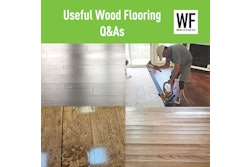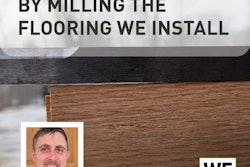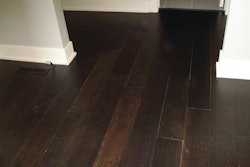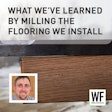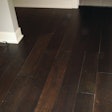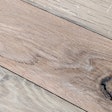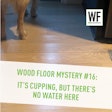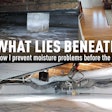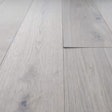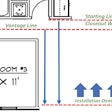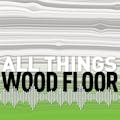I finally made sense of it; I solved the LVP question. What did I discover? What was the answer? I threw all my LVP samples in the trash and now refuse to sell, install or repair them.
“What the heck happened?” you might ask. Let me tell you all about it.
For starters, I put a floating LVP floor in my home (I know, I know, more on that soon) from front to back, except my master bedroom. I still have parquet there, and I like it better now that I “strayed” into LVP and learned what I’ll share below.
I put the LVP in my home because I have three dogs over 16 years old, and each one has health problems that can be summarized with multiple pee and poo sightings about the house several times a day. I chose the LVP as a retaliatory move because they destroyed the parquet in several rooms of my house. Dang it, why are my kids putting me through this? All of you with elderly dogs know where I’m coming from.
I had been selling LVP, as the clients seemed to want it, and I invested in the guillotine cutter and the Bullet Tools rip cutter, as well. I followed the install guidelines to the letter, completed a CaCl test on every project when it was over a cement slab and made darn sure the floors were as flat as possible—I spared nothing with the prep, just the same as when I’m installing a wood floor.
Despite that, I was getting random phone calls, emails and texts from prior clients about their LVP floors failing, and this was a terrible thing to experience. Not every job failed, but way too many to not mention. Two of my floors were inspected by the manufacturer, and they found nothing wrong with the installation. I even got a compliment from one of them for using the TiteBond two-sided tape to affix the T-moldings to the slab on a particular project.
Not good, guys! Not good to go through this knowing the floors were installed properly and were still failing. This harms my integrity, and that offends me.

One project failed because an office chair was rolling back and forth at the desk (see above). This curled the planks until the tongues and grooves split off and left large gaps because of the missing material. At first I had no clue why exactly this was happening—the maintenance guidelines from the manufacturers did not mention rolling chairs being an issue.
That’s when it hit me. I recalled an episode of “West Coast Choppers” wherein Jesse James put a curve into a flat sheet of metal that was to become a front fender. He was using a device called an English Wheel; it’s a simple unpowered device with two metal wheels that can be adjusted. Jesse was pushing a sheet through the wheels and tightening a knob that pushed the wheels closer and closer together as the piece moved through the wheels, and the flat metal began to curve. Recalling the office chair in my client’s home, I realized that was exactly what was happening. When the planks curled enough, the tongues and grooves failed, broke off in pieces and came apart, leaving a gap.
Also, it’s more than just rolling loads over the floor—it’s just plain traffic that will cause the floor to fail. One was around the busy home kitchen island, and three more were in heavy home traffic pattern areas like hallways or doorways.
Because of that being a normal occurrence in the home, I made the decision to cancel the LVP segment of my business. It just was not worth it anymore. We can install a perfect LVP floor, and it will still fail under normal use—not cool.
The profitability is gone if you consider the stress, liability and time spent talking to prior clients while trying to retain your integrity. This could go sideways in an infinite number of ways, with the very real possibility of being forced to fund a complete replacement on my dime no matter how much “proof” and documentation I could give to an attorney or Contractor’s License Enforcement Agent. No CYA process could protect me from just the right (wrong!) client and enforcement agent.

In my own home, I have one spot that is starting to cup right in the middle of the floor. I’m sitting here in my office (a different room) with my office chair rolling over an ⅛-inch Masonite panel that doesn’t look pretty just to avoid what I know will happen.
As I’m writing this, I am reading about the struggles of the Los Angeles fires in the Palisades area earlier this year and how the cleanup crews’ health is being threatened by the LVP floors there that are melted, causing real health concerns during the cleanup. My question is this: “Why put an LVP floor in a home that costs millions of dollars?” … but that’s another article. LVP flooring doesn’t decompose into the earth like wood does; it hangs around for hundreds of years instead. I know for a fact that all of the LVP floors I have removed and taken to the city dump are just thrown into the hole and buried, kinda like nuclear waste or something; I’ve watched it happen.
I’m going back to my roots: a wood flooring guy. I also try to talk every laminate client that calls into a wood floor, and hopefully I’ll never have to take on one of those jobs because business is slow.
We take our craft seriously, invest in expensive tools and expensive classes, stay involved in our industry and are proud of our work. After all that, if the product doesn’t stand up like it should and will not simply last as long as the warranty states, that’s a product I won’t use.
Some of us are installers and will not get these calls like the owners will, so take my argument wisely and don’t put these floors in your home or your relatives’ homes, because then you’ll be on the hook like I am. Just imagine the holiday family dinner when Auntie or Uncle ambush you in front of everyone to fix the floors you installed—for free. Take my advice: Don’t do it.
One more thing: You can’t tell anyone about this, because I’ll probably get more fix-it calls, and I don’t want them, even for a fee. I’d much rather fade back into the bushes like Homer Simpson so that I won’t come to mind for my prior clients if that LVP floor I installed for them eventually fails!














